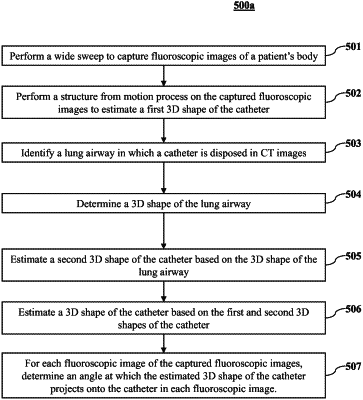| CPC A61B 6/12 (2013.01) [A61B 6/032 (2013.01); A61B 6/466 (2013.01); A61B 6/487 (2013.01); A61B 6/547 (2013.01); A61B 34/20 (2016.02); A61B 90/39 (2016.02); A61B 2034/2051 (2016.02); A61B 2034/2055 (2016.02); A61B 2090/3966 (2016.02)] | 17 Claims |

|
1. A method comprising:
receiving a plurality of fluoroscopic images of movement of a catheter captured by a fluoroscopic imaging device;
identifying a plurality of radiopaque tracking sensors along a length of the catheter in the plurality of fluoroscopic images of the movement of the catheter, yielding an identified plurality of radiopaque tracking sensors;
tracking, in the plurality of fluoroscopic images, movement of the identified plurality of radiopaque tracking sensors, yielding a tracked movement of the plurality of radiopaque tracking sensors;
determining three-dimensional (3D) coordinates of the catheter by performing a 3D structure from motion method on the tracked movement of the plurality of radiopaque tracking sensors;
determining a 3D shape of a body structure in which the catheter is disposed;
estimating poses of the fluoroscopic imaging device based on the 3D coordinates of the catheter and the 3D shape of the body structure;
determining, by an electromagnetic (EM) locating system, a location of the catheter based on signals from the plurality of radiopaque tracking sensors, yielding a determined location of the catheter; and
facilitating navigation of the catheter to a target area by indicating the determined location of the catheter in a display.
|
|
4. A method comprising:
receiving a sequence of a plurality of fluoroscopic images of a patient's body captured by a fluoroscopic imaging device;
identifying a plurality of radiopaque markers along a length of a catheter in the sequence of the plurality of fluoroscopic images of the catheter advancing through a patient's body, yielding an identified plurality of radiopaque markers;
tracking the identified plurality of radiopaque markers, yielding tracked movement of the plurality of radiopaque markers;
performing a 3D structure from motion method on the tracked movement of the plurality of radiopaque markers to estimate a first three-dimensional (3D) shape of the catheter;
determining a 3D shape of a body structure in which the catheter is disposed;
estimating a second 3D shape of the catheter based on the 3D shape of the body structure in which the catheter is disposed;
estimating a third 3D shape of the catheter based on the first 3D shape and the second 3D shape; and
estimating poses of the fluoroscopic imaging device based on the third 3D shape of the catheter.
|
|
9. A method for constructing fluoroscopic-based three-dimensional volumetric data of a target area within a patient's body, comprising:
acquiring a sequence of fluoroscopic images of the target area and movement of a plurality of radiopaque locating sensors of a medical device;
identifying the plurality of radiopaque locating sensors along a length of the medical device in the sequence of fluoroscopic images of the medical device advancing through a patient's body, yielding an identified plurality of radiopaque locating sensors;
tracking, in the sequence of fluoroscopic images, movement of the identified plurality of radiopaque locating sensors, yielding a tracked movement of the plurality of radiopaque locating sensors;
determining three-dimensional (3D) coordinates of the medical device by performing a 3D structure from motion method on the tracked movement of the plurality of radiopaque locating sensors;
determining a 3D shape of a body structure in which the medical device is disposed;
estimating angles of a fluoroscopic imaging device based on the 3D coordinates of the medical device and the 3D shape of the body structure;
constructing fluoroscopic-based 3D volumetric data of the target area based on the angles of the fluoroscopic imaging device;
determining, by an electromagnetic (EM) locating system, a location of the medical device based on signals from the plurality of radiopaque locating sensors, yielding a determined location of the medical device; and
indicating the determined location of the medical device in a display.
|